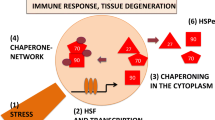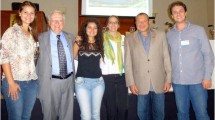Abstract
A collaborative workshop dedicated to the discussion of heat shock factors in stress response, development, and disease was held on April 22–24, 2014 at the Université Paris Diderot in Paris, France. Recent years have witnessed an explosion of interest in these highly conserved transcription factors, with biological roles ranging from environmental sensing to human development and cancer.


Similar content being viewed by others
References
Abane R, Mezger V (2010) Roles of heat shock factors in gametogenesis and development. FEBS J 277:4150–4172
Ahlskog JK, Bjork JK, Elsing AN, Aspelin C, Kallio M, Roos-Mattjus P, Sistonen L (2010) Anaphase-promoting complex/cyclosome participates in the acute response to protein-damaging stress. Mol Cell Biol 30:5608–5620
Akerfelt M, Morimoto RI, Sistonen L (2010) Heat shock factors: integrators of cell stress, development and lifespan. Nat Rev Mol Cell Biol 11:545–555
Anquez F, Courtade E, Sivery A, Suret P, Randoux S (2010) A high-power tunable Raman fiber ring laser for the investigation of singlet oxygen production from direct laser excitation around 1270 nm. Opt Express 18:22928–22936
Anquez F, El Y-BI, Randoux S, Suret P, Courtade E (2012) Cancerous cell death from sensitizer free photoactivation of singlet oxygen. Photochem Photobiol 88:167–174
Ben-Zvi A, Miller EA, Morimoto RI (2009) Collapse of proteostasis represents an early molecular event in Caenorhabditis elegans aging. Proc Natl Acad Sci U S A 106:14914–14919
Calderwood SK (2012) HSF1, a versatile factor in tumorogenesis. Curr Mol Med 12:1102–1107
Cho BR, Lee P, Hahn JS (2014) CK2-dependent inhibitory phosphorylation is relieved by Ppt1 phosphatase for the ethanol stress-specific activation of Hsf1 in Saccharomyces cerevisiae. Mol Micro 93:306–316
Craig EA, Gross CA (1991) Is hsp70 the cellular thermometer? Trends Biochem Sci 16:135–140
El Fatimy R et al (2014) Heat shock factor 2 is a stress-responsive mediator of neuronal migration defects in models of fetal alcohol syndrome. EMBO Mol Med 6:1043–1061
Elsing AN et al. (2014) Expression of HSF2 decreases in mitosis to enable stress-inducible transcription and cell survival. J Cell Biol, in press
Eroglu B, Min JN, Zhang Y, Szurek E, Moskophidis D, Eroglu A, Mivechi NF (2014) An essential role for heat shock transcription factor binding protein 1 (HSBP1) during early embryonic development. Dev Biol 386:448–460
Eymery A, Callanan M, Vourc’h C (2009) The secret message of heterochromatin: new insights into the mechanisms and function of centromeric and pericentric repeat sequence transcription. Int J Dev Biol 53:259–268
Fritah S et al (2009) Heat-shock factor 1 controls genome-wide acetylation in heat-shocked cells. Mol Biol Cell 20:4976–4984
Fujimoto M et al (2012) RPA assists HSF1 access to nucleosomal DNA by recruiting histone chaperone FACT. Mol Cell 48:182–194
Goloudina AR, Demidov ON, Garrido C (2012) Inhibition of HSP70: a challenging anti-cancer strategy. Cancer Lett 325:117–124
Guertin MJ, Lis JT (2010) Chromatin landscape dictates HSF binding to target DNA elements. PLoS Genet 6:e1001114
Jego G et al. (2014) Dual regulation of SPI1/PU.1 transcription factor by heat shock factor 1 (HSF1) during macrophage differentiation of monocytes. Leukemia Feb 7, Epub ahead of print
Jolly C, Metz A, Govin J, Vigneron M, Turner BM, Khochbin S, Vourc’h C (2004) Stress-induced transcription of satellite III repeats. J Cell Biol 164:25–33
Labbadia J, Morimoto RI (2014) Proteostasis and longevity: when does aging really begin? F1000Prime Rep 6:7
Le Masson F, Christians E (2011) HSFs and regulation of Hsp70.1 (Hspa1b) in oocytes and preimplantation embryos: new insights brought by transgenic and knockout mouse models. Cell Stress Chaperones 16:275–285
Le Masson F et al (2011) Identification of heat shock factor 1 molecular and cellular targets during embryonic and adult female meiosis. Mol Cell Biol 31:3410–3423
Mendillo ML et al (2012) HSF1 drives a transcriptional program distinct from heat shock to support highly malignant human cancers. Cell 150:549–562
Mjahed H, Girodon F, Fontenay M, Garrido C (2012) Heat shock proteins in hematopoietic malignancies. Exp Cell Res 318:1946–1958
Pennisi E (2013) The CRISPR craze. Science 341:833–836
Petre I et al (2011) A simple mass-action model for the eukaryotic heat shock response and its mathematical validation. Natl Computing 10:595–612
Pierce A et al (2013) Over-expression of heat shock factor 1 phenocopies the effect of chronic inhibition of TOR by rapamycin and is sufficient to ameliorate Alzheimer’s-like deficits in mice modeling the disease. J Neurochem 124:880–893
Pierce A, Wei R, Halade D, Yoo SE, Ran Q, Richardson A (2010) A novel mouse model of enhanced proteostasis: full-length human heat shock factor 1 transgenic mice. Biochem Biophys Res Commun 402:59–65
Prahlad V, Cornelius T, Morimoto RI (2008) Regulation of the cellular heat shock response in Caenorhabditis elegans by thermosensory neurons. Science 320:811–814
Raynes R, Pombier KM, Nguyen K, Brunquell J, Mendez JE, Westerheide SD (2013) The SIRT1 modulators AROS and DBC1 regulate HSF1 activity and the heat shock response. PLoS One 8:e54364
Reinke H, Saini C, Fleury-Olela F, Dibner C, Benjamin IJ, Schibler U (2008) Differential display of DNA-binding proteins reveals heat-shock factor 1 as a circadian transcription factor. Genes Dev 22:331–345
Rieger TR, Morimoto RI, Hatzimanikatis V (2005) Mathematical modeling of the eukaryotic heat-shock response: dynamics of the hsp70 promoter. Biophys J 88:1646–1658
Rossi A, Riccio A, Coccia M, Trotta E, La FS, Santoro MG (2014) The proteasome inhibitor bortezomib is a potent inducer of zinc finger AN1-type domain 2a gene expression: role of heat shock factor 1 (HSF1)-heat shock factor 2 (HSF2) heterocomplexes. J Biol Chem 289:12705–12715
Santagata S et al (2013) Tight coordination of protein translation and HSF1 activation supports the anabolic malignant state. Science 341:1238303
Schneider R, Linka RM, Reinke H (2014) HSP90 affects the stability of BMAL1 and circadian gene expression. J Biol Rhythms 29:87–96
Shinkawa T et al (2011) Heat shock factor 2 is required for maintaining proteostasis against febrile-range thermal stress and polyglutamine aggregation. Mol Biol Cell 22:3571–3583
Taylor RC, Berendzen KM, Dillin A (2014) Systemic stress signalling: understanding the cell non-autonomous control of proteostasis. Nat Rev Mol Cell Biol 15:211–217
Uchida S et al (2011) Impaired hippocampal spinogenesis and neurogenesis and altered affective behavior in mice lacking heat shock factor 1. Proc Natl Acad Sci U S A 108:1681–1686
van Oosten-Hawle P, Morimoto RI (2014) Transcellular chaperone signaling: an organismal strategy for integrated cell stress responses. J Exp Biol 217:129–136
Vihervaara A, Sergelius C, Vasara J, Blom MA, Elsing AN, Roos-Mattjus P, Sistonen L (2013) Transcriptional response to stress in the dynamic chromatin environment of cycling and mitotic cells. Proc Natl Acad Sci U S A 110:E3388–E3397
Vihervaara A, Sistonen L (2014) HSF1 at a glance. J Cell Sci 127:261–266
Vourc’h C, Biamonti G (2011) Transcription of Satellite DNAs in mammals. Prog Mol Subcell Biol 51:95–118
Westerheide SD, Anckar J, Stevens SM Jr, Sistonen L, Morimoto RI (2009) Stress-inducible regulation of heat shock factor 1 by the deacetylase SIRT1. Science 323:1063–1066
Whitesell L, Lindquist S (2009) Inhibiting the transcription factor HSF1 as an anticancer strategy. Expert Opin Ther Targets 13:469–478
Wirth D, Bureau F, Melotte D, Christians E, Gustin P (2004) Evidence for a role of heat shock factor 1 in inhibition of NF-kappaB pathway during heat shock response-mediated lung protection. Am J Physiol Lung Cell Mol Physiol 287:L953–L961
Wirth D, Christians E, Li X, Benjamin IJ, Gustin P (2003) Use of Hsf1(−/−) mice reveals an essential role for HSF1 to protect lung against cadmium-induced injury. Toxicol Appl Pharmacol 192:12–20
Zelin E, Zhang Y, Toogun OA, Zhong S, Freeman BC (2012) The p23 molecular chaperone and GCN5 acetylase jointly modulate protein-DNA dynamics and open chromatin status. Mol Cell 48:459–470
Acknowledgments
We thank all the participants for their contribution. The workshop was sponsored by CNRS (PICS Program) and Fondation Jérôme Lejeune and was greatly facilitated by the excellent assistance of Geneviève Fournier, Xavier Jourdan (UMR71216), and Françoise Chevalier (UFR “Life Sciences”, Paris Diderot University). We also thank Déborah Bouvier and Aurélie de Thonel from the Mezger laboratory for their time and efforts toward making the workshop a success.
Author information
Authors and Affiliations
Corresponding author
Rights and permissions
About this article
Cite this article
Morano, K.A., Sistonen, L. & Mezger, V. Heat shock in the springtime. Cell Stress and Chaperones 19, 753–761 (2014). https://doi.org/10.1007/s12192-014-0539-y
Received:
Revised:
Accepted:
Published:
Issue Date:
DOI: https://doi.org/10.1007/s12192-014-0539-y




